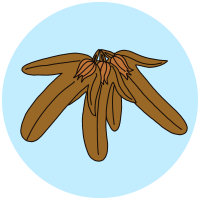
How to identify our most common tree seeds

Ash seeds (keys)
Ash seeds have a ‘seed’ at the top, and a long, thin papery wing underneath. They dangle in bunches from the branch tips.

Field maple
Field maple seeds are wide, large and stick out horizontally when in their pairs. They are often tinged with pink.

Hornbeam
Hornbeam seeds consist of a seed at the top, nestled between a three-lobed papery wing around and underneath.

Linden
Linden seeds grow in small clusters of 2-4 at the tip of the stem, which is wrapped around by a light, membranous leaf.

London plane
London plane seeds are small, tufted seeds, which grow in fuzzy balls, dangling beneath the branches.

Norway maple
Norway maple seeds are medium sized, frilly round the edges and grow in pairs, which stick out diagonally.

Pine
Pine seeds come in different shapes and sizes, but have a seed at one end, and a larger, thin, papery wing.

Sycamore
Sycamore seeds are small, and grow in pairs that hang close together, with the seeds at the top and wings beneath.

Wych elm
Wych elm seeds consist of a flat, round seed nestled in the middle of a flat, round, thin, membranous wing.
What are seeds?
Seeds are basically the babies or offspring of parent trees. They are produced following pollination of the trees’ flowers and contain all the genetic material of the tree. Inside, they have a supply of food and nutrients ready to start their journey into new trees and in fact, they are specially adapted to disperse away from their parent trees by flying, floating, bouncing or rolling away (or being eaten and taken away – sometimes inside a juicy fruit!) This helps them find the space to grow and mature without competing with their parents for water, nutrients and sunlight.
Which trees have nuts and seeds?
There are many sizes and shapes of tree seeds, but usually, we only notice the larger sized seeds. The nine seeds you are likely to notice on your nature walks: ash, field maple, hornbeam, linden, London plane, Norway maple, pine, sycamore and wych elm. Some of the smaller seeds you might come across, are alder, birch and willow.
The six most common ‘nut’ producing trees, are: beech, hazel, horse chestnut, oak, sweet chestnut and walnut. You can learn to identify our most common nuts here.
Summary
Well, there we go! I hope you enjoyed this tutorial and have a better idea now, of how to identify our most common tree seeds. To be notified about new nature walk tutorials, you can join the Nook by clicking the button below x

